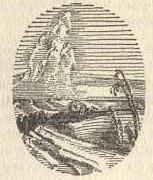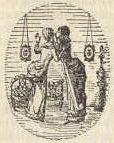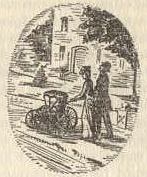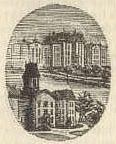Resource Center
On-Line Library

The Last Frontier
THE
crudities of the village that was the Prairie Capital, in its
first decade were not peculiar to it. They were common to all the
towns of the region, and indeed, to most of the towns and cities
of the country. In older and richer communities there was more
display of wealth and luxury, mostly in food, clothing. and a
gingerbread architecture. But no wealth could buy and no poverty
withhold those services and conveniences today so indispensable.
They simply did not exist.
In the case of Lincoln and the trans-Missouri
region in which it lay, there were special reasons for the
crudities of life. This was the last frontier. Its life was one of
deprivation, hardship, and makeshift. It was wholly in character
for frontier homes and towns to be merely shelters from sun and
storm.
T H E P R A I R I E C A P
I T A L
![]()
There was no time, even if there had been
money, to spend on anything but the essentials of life. The
pioneer is an individualist. Save in moments of common danger he
works badly with neighbors. A community sense and a community
spirit is about the last to develop in a frontier town. Until it
did develop the towns were pretty much every-where what Lincoln
was.
There were reasons peculiar to the capital for
the character of its growth. It was a fiat town. When Nebraska
became a state, the rivalries of its older settlements had forced
the location of the new capital upon a remote site, difficult to
get to, and with almost no natural or commercial advantages. Its
growth has been amazing. It won became itself a rival of the older
rivals. It had been built from nothing by an act of the
legislature. Another act of the legislature relocating the capital
might reduce it again to nothing. Indeed the effort to do so had
been made and had been defeated by methods, some of which perhaps
would not bear scrutiny. Its tenure was uncertain. Its title was
or might be clouded. It is no wonder that it was built with
reference to the uncertainties of the future.
But on that day in 1880 when the Prairie Capital
strutted a little in the pride of its 13,003 souls, many of these
uncertainties had vanished. Its mere size made it less subject to
attack. A new and far greater capitol was being built. The
University had two hundred inmates; the penitentiary nearly as
T H E P R A I R I E C A P
I T A L
![]()
many, and the Lunatic Asylum only slightly less. Railway service was improving and more railroads were a certainty. Crops were good and prices satisfactory. Public sentiment began to favor public improvements. Rumors of a contraption called a telephone, and of a light that used neither oil nor gas, were current. Some daring souls openly advocated bringing them to town. Horse cars were to come, and granite-paved streets where iron shod wheels and boots would wake the echoes and nearly wake the dead. Water works, sewers, lights, police--but what's the use. Optimism filled the air. The Prairie Capital had hit its stride. It had its second wind. It was on its way. Just where it was going was is little indefinite. But it was moving and sure to arrive somewhere.
T H E P R A I R I E C A P
I T A L
![]()

Slander
It
was a slander to call the great plain of which Nebraska is
a part the "Great American Desert." But it was not malicious and
not intentional slander. And those who spread it did not whisper
it as one gossip to another. They told it to the world. They
printed it in the geography.
The ill fame of the region was undeserved, yet
it was natural. From the time of the earliest fur trader to the
coming of the railroad, the region had been seen and described by
more men than any other unsettled area on the continent. Probably
a half million men and women had crossed it or tried to. They
generally agreed that it was a place forever unfit for the homes
of men. There were a few that had a different and a juster notion.
But they were not heard or heard only to be ridiculed.
Everybody
[23]
T H E P R A I R I E C A P
I T A L
![]()
knew the country knew it as a barrier to a distant goal. They
were all going somewhere else. They were headed for the trading
posts of the Spanish southwest, or for the new Zion on the Great
Salt Lake, for Oregon or for the placers of Sutter's Mill. Their
eyes were on the distant rainbow. The very extent of the plains
made a formidable obstacle to the slow transport of the time.
Their hearts sickened at the long, passage. Had the hardships of
the journey been less than they were, and had the prairies been
even more desirable than they were, still to most travelers they
would have been a place of hopes deferred.
The plains were unlike the forested regions from
which the early travellers came. They thought of farms cleared
from the woods, here was no woods out of which to hew farms or to
build houses. Here was no stone to build fences. They thought of
transportation in terms of boats and ox teams. Here were no rivers
for boats and the ox team was all but lost in the vast stretches
of the prairie. The land truly seemed to them as savage as its red
defenders.
So rose the myth of the American Desert. It
remained intact when the Civil War ended. Thousands of men, young
and of the best blood of the nation were returned by peace to
civil life. The thought of life, placid, orderly as they knew in
the towns and farms of New England, Pennsylvania or the Ohio
Valley was unendurable. They looked
T H E P R A I R I E C A P
I T A L
![]()
around for a field of more adventurous action. Just at this moment a new state was formed. It lay on the borders of the great desert. Its extent was vast. Its possibilities were vaster. Nebraska was a virgin field for the state builder, for the city builder, for the home maker. State and city might he whatever the people who went there wanted them to be. Over all was the glamor of risk, of privation, of adventure. Its appeal was irresistible. From all the northern and the border states young men and their young wives came to build in the Great American Desert their own state and its prairie capital.
T H E P R A I R I E C A P
I T A L
![]()

The City of Youth
THE
Prairie Capital in its first year was preeminently a city of young
men and women. In this it was not unlike all towns of the region
misnamed the "Great American Desert." The spirit of the times and
the conditions of life in the new state were such as to make an
irresistible appeal to the adventurous. Only the young and strong
were attracted, and only the young and strong could endure the
rigorous conditions of the frontier. It is often said that it is
the boys that fight the wars. It is also true that it is the boys
that settle the frontiers. In the case of Lincoln all these young
citizens had their young and growing families. It is a wonder
somebody did not start a baby buggy works. There would have been a
large home demand for his products.
That the youthfulness of the citizens of the
new
T H E P R A I R I E C A P
I T A L
![]()
capital is not wholly the impression of an old and imperfect
memory is easily demonstrated by a few figures. In 1886 the
governor of the state was 32. The Chief Justice was not yet 40.
The average age of the legislature was 34. The mayor of Lincoln
was in the thirties. Many lawyers of distinction were under
thirty. John Fitzgerald, the man who built the railroads, the
leading banker and the city's first millionaire, was 31. So was R.
E. Moore, then laying the foundations of his long distinguished
career and of his fortune. C. H. Morrill, was 35. S. H. Burnham
was 30. John E. Miller was just past twenty. The Chancellor of the
University was the oldest of the prominent citizens, as was proper
to his office. He was fifty. There were indeed a few older
Citizens but for the most part they were the parents of the youths
who had preceded them to the frontier state and its prairie
capital. Some of these were sixty. "Grandpa" Peck (on account of
his great age he was Grandpa Emeritus to the whole town) was
eighty and he got his name in the paper because of it.
They did not look so young, some of these
adventurous boys. Whiskers were in fashion. And more of the men
followed the fashion. Not all of them were like Shakespeare's
soldier, "full of strange oaths." but many of them were, "bearded
like the pard." And there were some magnificent examples of
hirsute splendor. Mr. H. W. Brown was known to his friends and
intimates as a scholar and a gen-
T H E P R A I R I E C A P
I T A L
![]()
tleman. His fame was great among those not so fortunate as to
be in that circle for the wonderful beard he wore. It is
impossible to describe the confidence inspired by the sight of
Judge Cobb's famous white heard. He deserved and received the
trust of the state in his high office as Chief Justice he rendered
a distinguished service. He had great learning and greater
honesty. The benign wistom of his kindly bearded face can never be
forgotten.
Some of the bearded were served well by their
facial camouflage. Aside from the fact that a full crop of chin
alfalfa permitted a great economy in neckties and collars,
whiskers also covered some weak chins and cruel mounths. When the
fashion changed and new mown cheeks were de rigour, some
reputations were sadly damaged. Some beards never should he shorn,
just as some skirts never should be shortened.
T H E P R A I R I E C A P
I T A L
![]()

Asylum-University
THE
legislature by its fiat created the Prairie Capital on the fringe
of the desert. By an act of like legerdemain it provided for a
complement of institutions necessary for the service of the new
state. In course of time many others were added to the list. As
population grew and as property and wealth began gradually to
increase, new needs appeared and new sources from which money
could be drawn to supply them. But at first the state could supply
only the essential demands.
Provision was made for a Capitol, a University,
a penitentiary, and a Lunatic Asylum. The irony in the grouping of
these agencies in one program did not escape the sarcastic wit of
the time. The solons had justified their claims to wisdom in
erecting in one legislative day both University and Asylum.
The
T H E P R A I R I E C A P
I T A L
![]()
Asylum would be needed to provide teachers for the University.
The University would be needed to provide inmates for the Asylum.
Opponents of the whole set-up admitted that a University was
needed to instruct the fools who wanted the Asylum; and that the
Asylum was needed for the nit-wits who thought the state needed or
could ever have a University. Both sides agreed upon the necessity
for a prison. It would be needed to confine the criminal other
side.
These institutions of the state existed at
first, of course, only on paper. When actual erection of actual
buildings began it soon appeared or was alleged, that the paper
foundation was in some respects more substantial than the stone.
The buildings were built hurriedly, without proper engineering or
architectural advice. The materials, especially the native stone,
were untried and untested. They had to be laboriously and
expensively hauled from far away. The inevitable charge of graft
was made. Impeachment and prosecution followed. Official
reputation was shown to have foundations as flimsy as the
buildings had. In an atmosphere of charge and counter charge, of
scandal and gossip the Prairie Capital began its career.